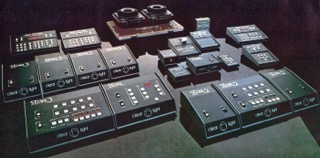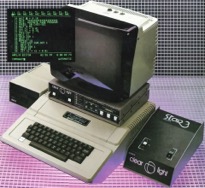A view of Lake Pend Oreille from the mountainside northwest of Sandpoint, and just west of the Airport. My home is just below this viewpoint.
First Photo Trip
The year before I graduated MIT in 1971, I took my first trip to the US Southwest - Grand Canyon, Bryce Canyon, Zion Canyon, and others, with some friends from MIT. In those days I was using slide film (Agfachrome 100) because it cost too much to do prints, and I enjoyed giving "slide shows" to the Grad Group. Unfortunately, most of the slides from the 70's and early 80's were destroyed by humidity when I moved to Florida in 1979.
It was during this trip where the relationship with my wife-to-be developed, via lots of postcards with "xxxx's" and "oooo's" on them. This was no doubt due to camping for a month with 3 guys! When I returned, she visited Boston to "collect" on the promised hugs and kisses.
Eric C. Anderson Autobiography 3
The Clear Light Years
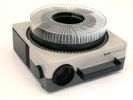
Kodak Carousel Slide Projector

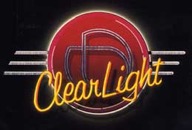
Ultimately, the company became an electronics company, based on the products I developed, and the name was changed from Clear Light Productions to Clear Light, Inc. We moved the company to Ft. Lauderdale, Florida in 1979, where I lived for 8 years.
The Clear Light Experience
After marriage in 1971, we continued to live in Boston - Newton, actually, until 1979. In 1971, I was one of the founders of Clear Light Productions - later just Clear Light, Inc. This Christian start-up company was founded by myself and some friends from Park Street Church to use multi-media to present the Gospel of Jesus Christ to secular man. We used banks of slide projectors and other devices to do this, along with rock music. We got tossed out of Park Street Church for using rock music! As things developed, we presented a 6-projector show entitled "Cry 3" to over 500,000 people in churches, schools, universities, on beaches, in parks, etc., over a 5 year period, using seminary students to cart around the equipment and give the presentations. The follow-on production, "Because I Am" was never produced, except in record form (hey - they didn't have CD's back then!).
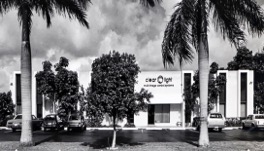
Clear Light Headquarters in Pompano Beach, FL, 1979
Engineering at Clear Light
My responsibility as Chief Engineer - later Senior VP of Engineering - was to create the hardware to drive the projection equipment. It started out with manual "dissolve units" driven with simple analog circuitry and relays, moved to tone encoded simple digital systems using PLL's (Phase Locked Loops), then to paper tape with SSI CMOS chips, next to pure digital with MSI CMOS, and finally to microprocessor-based designs. Our first microchip was the Fairchild F8 series, in the form of a Mostek 3870 single chip computer. That was a great little chip! Really compact 8-bit instruction set, on-board 2K ROM, and about 36 pins of I/O. Programmed on a TI "silent 700" cassette-based terminal! Was that a trip! It took 15 minutes to run the 2-pass assembler...
The Apple Connection
In 1979, we began looking for a microcomputer to base our future products on. Up to then, we had introduced products based on various technologies, beginning with "manual" controls, and then moving up as the microelectronics industry developed:
- The 1200 System: paper tape and tones
- The Diamond System: digital CMOS logic, SSI and MSI
- The Star System: 3870 microcomputer based - typically 2 per unit. A 15-projector system was a network of 13 3870's.

Our competitors were using S100-based computers. These were very heavy, and used lots and lots of parts, plus an external CRT terminal. When I finally saw my first Apple // computer, with switching power supply, single, simple motherboard, integrated keyboard, sound and graphics, I knew it was the right choice.
Eric, doing a demo on the Clear Light Superstar Concept at a Trade Show
From this, we created the Clear Light Superstar computer, one of two Apple "co-branded" versions of the Apple // ever allowed. The other co-branded Apple // was the Bell & Howell black version. In this photo, supplied by an old friend, you can see me demonstrating the Superstar to a customer at a trade show, probably around 1983.
A co-branded Apple II had Apple logos and our logos on the name plates for the disk drives and the computer itself. Below is a picture of the Apple II name plate for the Superstar:

Clear Light Superstar co-brand Apple // label
Multi-Tasking on an Apple II!
With the Superstar, you could program up to 4 "time lines" at once. A task or alternate time line was started via the "Start Task' command. This unprecedented capability (for programming slide projectors) allowed independent functions to be programmed independently. For example, you could create one task to do a marquee effect with 3 projectors, and synchronize other projectors to the beat of the music with another, while changing subtitles to the voice track on another. The computer would "merge" the timelines together into a single "cue track" for the projector controllers in real time.
The entire system could run at 100 cues per second, and could process control statements (non-projector statements) at over 1000 statements per second. Our competitors could not match the performance or ease of use, even when using a much more powerful IBM PC and C programming. It was too slow to use! Ah, there IS some value to a current day high-powered CPU chips, after all! To suck up all the C compiler and operating system overhead! Not to mention the now commonplace graphical user interface overhead…
There are many other Clear Light stories, but enough! The Clear Light experience lasted until 1987. During the 16 years with Clear Light, I was very productive: I developed and shipped over 55 products, from manual controls to Apple II-based products. We had the best products. Too bad we didn't know how to spell "marketing." You can see more photos from my Clear Light days on my Clear Light Photos page, and hear some of the soundtracks and music we created on my Clear Light Media page.


Eric

Sandy
Family Experiences
In 1974, we had our first and only child - Adam Christian Anderson. Adam was a delightful child! Sandy became a full-time mom, and together we raised a wonderful son. When we left Ft. Lauderdale, Florida in 1987 to move to San Jose, California for my new job at Apple Computer, Inc., Adam was in 8th grade. He attended Ft. Lauderdale Christian School during the first 7 grades. It was a painful transition to the public school system - even for a school with a great reputation in Cupertino.
Adam graduated from high school, and then attended Santa Clara University, where he got his B.S. in Computer Science in 1996. Adam is now a consultant, doing database systems for various clients, and currently lives in Florida.
Sandy also attended Santa Clara University, and gained a MS degree in Counseling Psychology. She then worked her 3000 hours as an intern, and took the state boards. After receiving her license, she opened a successful private practice for child and family therapy in San Jose. She closed her practice in late 2002 for our move to Nevada.

Adam
Big Changes!
In the mid 80’s, I began to develop cataracts. Naturally, this was a big concern, but the doctor told me it would be just fine - wait for a little while and then we will remover them. When the day came, I asked the doctor what they would put in my eye after taking out my frosted lens. His response freaked me out: "nothing." Whaaa….? I imagined the view in my viewfinder when I take off the lens. It is just colored light! How would I see anything? He explained that my cornea was also a lens, and I would see well with that.
He was right on. I needed some correction, but not much, in compared to the "coke bottle bottom" lenses I was used to: -19 diopters. Everything was now bigger and closer! I could actually see better than ever (but still legally blind).
What the doctor failed to mention was that - with such nearsighted eyes, cataract surgery often results in retinal detachment. And sure enough, in 1989, while on a weekend retreat, my left eye retina began to detach. It appears as a dark curtain coming across your view, as the retina lifts off the rear of the eye.
After one failed attempt to reattach, the doctor did a "vitrectomy" where they open the eye, carefully remove the virtuous humor, replacing it with some special gas, and seal it up. It takes a month for the special gas to be absorbed, replaced with clear fluid. It is quite unnerving to see fluid sloshing around in your eye (and not seeing out). When it was all done (bubbles remains for another month), I could again see better than ever before - all the floaters and other debris were gone!
The right eye did not go so well (different idiot doctor). That eye can barely see, and often is in pain due to a damaged cornea. But I do have one good eye - still legally blind, but so very much better than ever before! Thank God for that!

What you see when you are getting a retina detachment

A side view of a retinal detachment
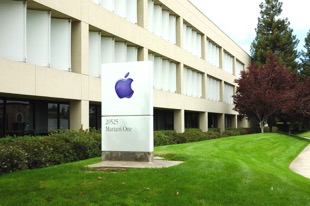
Mariani One: the home of CPU Engineering for both Apple II and Macintosh in 1987, when I joined Apple
Transitions: from Clear Light to Apple Computer, Inc.
When it was time to let Clear Light go - slide projectors were on the way out - I began looking for a new job. The only company I truly wanted to work for besides Clear Light was Apple Computer, Inc. - since then, renamed simply to just Apple, Inc. I read everything I could about the company, the products, and the people. Cupertino was some mysterious place on the west coast where all the interesting things were happening!
I got my first nibble in the summer of 1986 from Larry Tessler, who was in charge of the Advanced Products Group, which later became the Advanced Technology Group. Larry asked me a question: "Do you want to do products or research?" I guessed the wrong answer, based on the name of his group, and said "products!". Oops... I was devastated when I found out that the "right" answer was "research."
Fortunately, my wife Sandy had more faith than I did. I gave up on Apple - it was too painful to consider having been rejected by the one company I wanted to work for! Sandy prayed for a year that Apple would contact me again and offer me a job.
Sure enough (Hey! God answers prayers!) in the summer of 1987, I got a call from John Medica (now at Dell Computer) following up on a resume from the previous year. I had just sent in a new one, but he was not aware of it. Over the next few weeks, I visited Cupertino and Apple several times, and moved out quickly to my new job in the CPU Engineering Group! I was in nerd heaven! Mariani One was my first work location. Over the years, I worked from a number of buildings, and ended up at the end at the then brand-new One Infinity Loop, until our departure in 1996, So I can understand the excitement the current employees have toward the new Spaceship building!
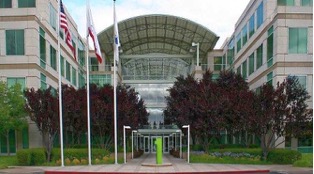
The entrance to One Infinity Loop, Apple’s first circular campus, where I ended up at the end of my career at Apple! It was quite exciting to move into a new facility, and I am sure the current employees are going to be thrilled to move into the new Spaceship facility!
Previous Page
Next Page
Copyright © 2017 Anderson Creations. All Rights Reserved.

